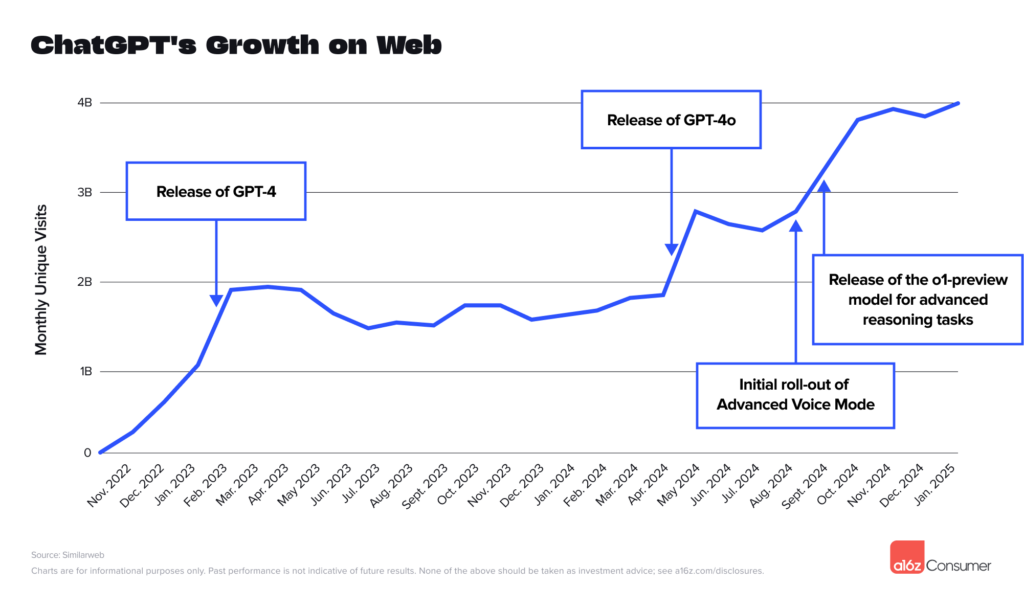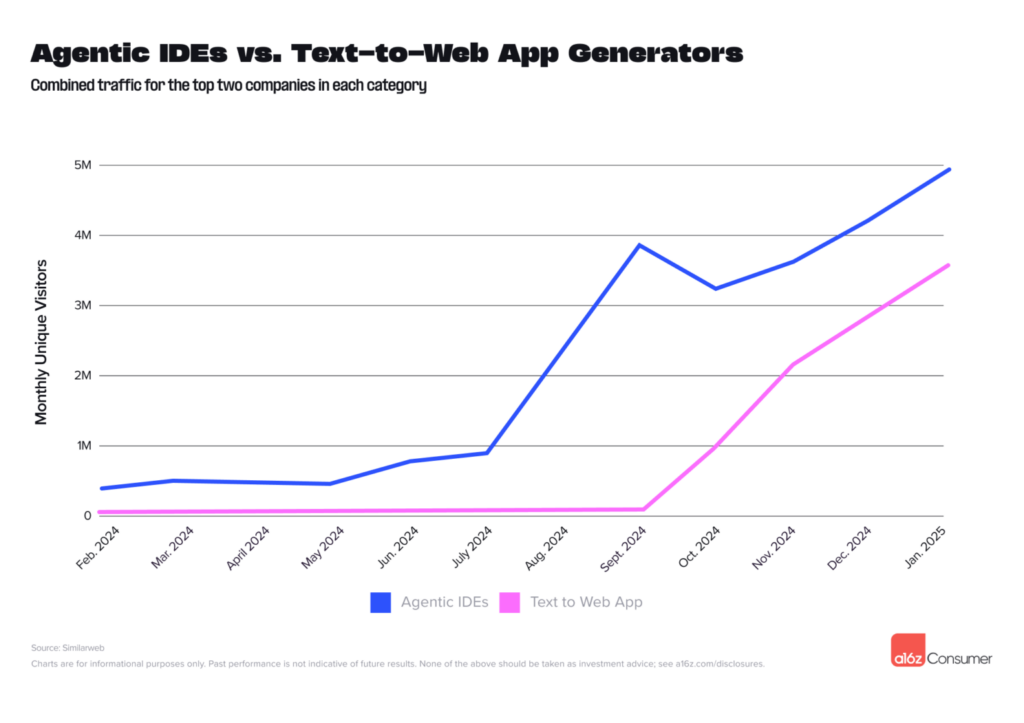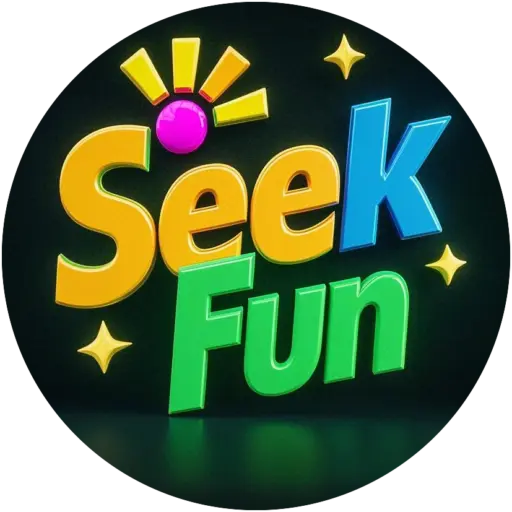In just six months, the consumer AI landscape has been redrawn. Some products surged, others stalled, and a few unexpected players rewrote the leaderboard overnight. Deepseek rocketed from obscurity to a leading ChatGPT challenger. AI video models advanced from experimental to fairly dependable (at least for short clips!). And so-called “vibecoding” is changing who can create with AI, not just who can use it. The competition is tighter, the stakes are higher, and the winners aren’t just launching, they’re sticking.
We turned to the data to answer: Which AI apps are people actively using? What’s actually making money, beyond being popular? And which tools are moving beyond curiosity-driven dabbling to become daily staples?
This is the fourth installment of the Top 100 Gen AI Consumer Apps, our bi-annual ranking of the top 50 AI-first web products (by unique monthly visits, per Similarweb) and top 50 AI-first mobile apps (by monthly active users, per Sensor Tower). Since our last report in August 2024, 17 new companies have entered the rankings of top AI-first web products.

ChatGPT’s Growth
When ChatGPT launched in research preview in November 2022, it became the fastest-growing consumer app ever, reaching 100 million users in just two months. However, usage soon plateaued, with global monthly visits nearly flat between March 2023 and April 2024.

More recently, growth has come roaring back. It took nine months for ChatGPT to grow from 100 million weekly active users in November 2023 to 200 million in August 2024. Typically, growth becomes more challenging at scale, but in this case it took less than six months to double again — reaching 400 million weekly active users by mid-February 2025.

ChatGPT’s mobile data tells a more consistent growth story. Since its launch in May 2023, monthly active users have steadily increased by 5 to 15% every month over the past year, as web users also adopted the app. According to Sensor Tower estimates, out of ChatGPT’s 400 million weekly active users, 175 million now use the mobile app.
DeepSeek Debuts
DeepSeek made a big splash in more ways than one. Though its public chatbot only launched on January 20, it racked up enough traffic in just 10 days to rank #2 globally among all AI products for the month.
DeepSeek was developed by the Chinese hedge fund High-Flyer, and the plurality of usage (21%) in January 2025 came from China, where ChatGPT is banned. Other top countries for DeepSeek include the U.S. (9% of traffic) and India (8%). DeepSeek has been banned or restricted in some countries, including South Korea, Australia, and Taiwan, as well as on government devices in several U.S. states.
DeepSeek’s launch significantly outpaced most other general assistant LLMs. The company reported 1 million users in 14 days — slower than ChatGPT’s 5-day mark — but then surged past 10 million users in just 20 days, beating ChatGPT’s 40-day milestone.

DeepSeek’s growth among the tech and research community was driven by its strong performance on reasoning benchmarks and its headline-grabbing claim of achieving those results with just $5.6 million in training costs — a fraction of what competitors have spent.
Its claim about training costs sparked broader media attention, generating mainstream discussions of a “Sputnik moment” for AI. According to Google Trends, global search interest for DeepSeek matched ChatGPT on January 27, and even surpassed it in the U.S.!
AI Video’s Breakthrought
AI video has been on the brink of true usability (with reliable outputs) for the past 18 months, but the last six months finally delivered major progress in quality and controllability. Three new companies — Hailuo (#12), Kling AI (#17), and Sora (#23) — debuted on the web rankings, joining InVideo (#37). Runway and Krea (which allows users to generate videos across models) made the Brink List.
Hailuo (maker of the MiniMax model series) and Kling are both Chinese video models — Kling launched in June 2024, followed by Hailuo in September. As of January 2025, both surpassed Sora in monthly visits. While Sora was first previewed in February 2024, it wasn’t released until December 2024.
We are beginning to see fragmentation across video model providers. They’re diverging in both output style and user interface, offering creators more specialization. Sora is known as a versatile, all-around video generator, Hailuo excels in strong prompt adherence, and Kling offers extra features like camera movement control and lip sync.
Tools for Devs
It’s the era of the builder — and AI-powered tools are rising to meet demand. Two categories of products have exploded in the last six months, targeting different audiences: (1) agentic IDEs (integrated development environments) designed for developers; and (2) text-to-web app platforms accessible to both technical and non-technical users (deemed “vibecoders” by Andrej Karpathy).
Agentic IDEs like Cursor act as co-pilots for developers, with features like bug checking, autocomplete, and full code generation. Cursor debuted at #41 on our web ranking — the company recently announced that it serves hundreds of thousands of developers.
By contrast, text-to-web app products don’t require users to be technical. Anyone can input a text prompt and get a usable website or web application, which can feel like magic. These products are emerging now for a variety of reasons: models are finally able to generate executable code, web frameworks have matured, and platforms can take advantage of libraries and SDKs from companies like Resend, Clerk, and Supabase.

Like agentic IDEs, leaders in this space are growing fast. Bolt debuted at #48 on the list, while Lovable landed on the Brink List. Bolt reported reaching $20 million in annualized revenue and 2 million registered users within its first two months, while Lovable reported growing to $17 million in annualized revenue in its first three months.
In terms of monthly unique visitors (not visits) on web, the top two agentic IDEs are currently outpacing the top two text-to-web app builders, though both categories are growing at a similar rate. We’re interested to see how this evolves. Agentic IDEs require users to be technical, but every developer can (theoretically!) find value from using one on a near-daily basis. In contrast, text-to-web app platforms cater to the 99% of consumers who aren’t coders, but require users to have an idea of what they want to build.
* * *
AI-native products are scaling faster and engaging users more deeply than ever. Though things are moving fast, there’s still a lot of ground left to break. AI will underpin category-defining companies in the years ahead, but the race to shape its future is already well underway — gaining momentum, mainstream adoption, and real revenue.
Links: Top 50 Gen AI Consumer Web Products
Links: Top 50 Gen AI Consumer Mobile Apps
Charts and graphs provided within are for informational purposes solely and should not be relied upon when making any investment decision. Past performance is not indicative of future results. The content speaks only as of the date indicated. Any projections, estimates, forecasts, targets, prospects, and/or opinions expressed in these materials are subject to change without notice and may differ or be contrary to opinions expressed by others.
This article is republished from AH Capital Management, L.L.C. under a Creative Commons license. Read the original article.



